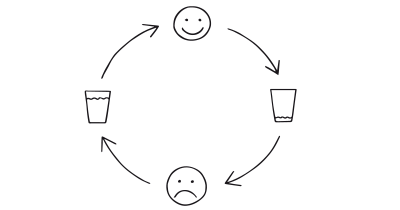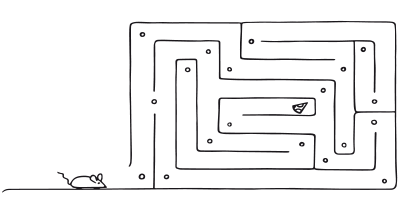Persuasive Patterns: Temptation
Goal-Gradient Effect
Our motivation increases as we move closer to a goal

The Goal-Gradient Hypothesis suggests that the closer we perceive ourselves to a goal, the more energized our behaviors become toward reaching it. This concept was originally studied in animals but has since been extensively applied to human behavior, particularly in settings involving tasks and rewards. The principle is crucial in designing systems that leverage incremental progress visibility to spur continuous engagement. By making the proximity to goals clear, this pattern can effectively enhance effort and persistence across various applications.
Imagine a person trying to get into shape by committing to run a marathon. Initially, the goal seems daunting and progress feels slow. However, as the event date approaches and their training log shows more miles covered, their motivation surges. They run more frequently and with greater intensity as the race day nears, driven by the visible decrease in remaining preparation time and the increasing tally of completed training sessions. This surge in effort as they approach their goal exemplifies the Goal-Gradient Effect in a common fitness journey.
Similarly, consider a language learning app that employs a similar principle. Users set a goal to achieve a certain level of proficiency. The app displays their progress in a visual format, such as a progress bar or a series of levels. As users complete each lesson and see themselves advancing closer to their target proficiency level, their engagement and frequency of practice typically increase. Just as the marathon runner is spurred on by nearing the race day, learners are motivated to complete more lessons as they perceive their goal within reach. This strategy harnesses the Goal-Gradient Effect by providing continuous feedback and visible milestones, enhancing user motivation and retention in the learning process.
Rats and mazes
One of the foundational studies illustrating the Goal-Gradient Effect was conducted by Clark Hull in 1932, who proposed that the drive to reach a goal intensifies as one approaches it. Hull’s theory was initially tested on rats in mazes, observing that the animals ran faster as they got closer to the food reward at the end of the maze. This early behavioral study laid the groundwork for understanding how proximity to a goal can enhance motivation not just in animals, but in humans as well.
Hull, C. L. (1932). The Goal-Gradient Hypothesis and Maze Learning. Psychological Review, 39(1), 25-43.
The Goal-Gradient Effect is rooted in the psychological principle that motivation to reach a goal increases as one gets closer to achieving it. This effect is based on the concept of “effort justification,” where individuals value goals that they invest significant effort into reaching, and as they approach the goal, their investment increases, thus enhancing their motivation. The principle is also supported by the cognitive phenomena known as the “endowed progress effect,” which posits that when people believe they have made some progress towards a goal, they are more motivated to complete it.
The effect of customer loyalty programs
In the realm of consumer behavior, a more contemporary study by Kivetz, Urminsky, and Zheng (2006) reinvigorated interest in the Goal-Gradient Hypothesis by demonstrating how customers enrolled in loyalty programs accelerate their purchase frequency as they approach rewards thresholds. This study not only confirmed Hull’s earlier findings in a modern context but also provided actionable insights for designing customer loyalty programs and other motivational structures in business settings.
Kivetz, R., Urminsky, O., & Zheng, Y. (2006). The Goal-Gradient Hypothesis Resurrected: Purchase Acceleration, Illusionary Goal Progress, and Customer Retention. Journal of Marketing Research, 43(1), 39-58.
Behavioral psychologists explain this effect through reinforcement theory, which suggests that behaviors leading to positive outcomes are likely to be repeated. As individuals approach a goal, the anticipation of the reward increases, which acts as a reinforcer, intensifying efforts towards the goal. This psychological dynamic is crucial in understanding consumer behavior, learning patterns, and personal development, where visible progress towards a goal can significantly amplify commitment and effort.
Designing products using the Goal-Gradient Effect
Incorporating the Goal-Gradient Effect into product design can significantly enhance user engagement and motivation to reach completion or achieve specific goals. By carefully structuring the user’s journey to highlight their progress and proximity to achieving their goals, designers can significantly influence user behavior and interaction.
Follow the guidelines below to ensure its effectiveness:
- Visualize progress
Effective use of visual tools such as progress bars or completion checklists is critical. For instance, an educational platform might implement a dynamic progress bar that fills up as students complete each section of a course. This visual cue not only provides continuous motivation but also gives learners a tangible measure of how close they are to their final goal. Ensure that progress indicators are clear and consistently updated. Visual representations like progress bars or step counters can be instrumental in showing users how close they are to achieving their goals. - Set micro-goals
Dividing larger objectives into smaller, achievable steps can sustain motivation over longer projects. For example, a project management tool might break down a project into phases, and completing each phase rewards the user with visual feedback. Each completed micro-goal encourages the user to start the next one, maintaining momentum and engagement. - Improve the approach to the goal
As users draw closer to their goal, intensifying positive feedback can amplify their motivation. This could be implemented in a fitness app where users receive more frequent congratulatory notifications as they near the end of a 30-day fitness challenge. The closer they get to their goal, the more enthusiastic and supportive the feedback becomes. - Streamline the final stages
Ensuring that the final steps towards goal completion are straightforward and uncomplicated is crucial. In an e-commerce environment, simplifying the checkout process as users complete their purchases can prevent drop-offs and improve conversion rates. This could mean reducing the number of steps to checkout or providing a clear and concise summary of the items they are about to purchase as they conclude their shopping. - Provide continuous feedback
Providing ongoing feedback about progress is essential for keeping users informed and engaged. A language learning app, for example, could use pop-up messages to give users immediate feedback on their quiz performances, suggesting what they can do next to improve or move closer to mastering a language level. - Implement end-point rewards
Marking the achievement of goals with significant rewards can greatly enhance user satisfaction. For instance, upon completing a year-long subscription, a streaming service might offer a free month or an exclusive preview of a new series as a reward. These rewards not only celebrate the achievement but also encourage renewal and continued engagement. - Use gamification elements
Integrating gamification elements such as scoring, badges, and leaderboards can make reaching goals fun and competitive. For instance, a mobile game that awards players with badges for completing levels within a certain time frame can stimulate continued play and progression through the game’s levels. - Manage negative experiences proactively
Monitoring for and addressing potential frustrations is key. If a user interface element consistently leads to user errors, redesigning that element or introducing helpful tooltips can mitigate frustration and keep the user experience positive. - Delight with celebratory visuals and interactions
Using vibrant visuals or animations upon completing tasks can make the experience more delightful. For example, a productivity app might celebrate the completion of a task list with cheerful animations or sounds, reinforcing a sense of accomplishment. - Adjust Reward Schedules
Calibrating the pacing and timing of rewards according to user engagement levels is crucial. A fitness tracker could adjust its reward system based on the user’s activity level, offering more immediate rewards to a beginner to keep them motivated or spacing them out more for a seasoned user who is less reliant on immediate feedback.
Each element should be carefully considered and tailored to fit the specific context and goals of the product, ensuring that the end experience is both rewarding and memorable.
Ethical recommendations
The Goal-Gradient Effect has the potential to be misused when it manipulates users into undesirable or harmful behaviors by over-emphasizing near-term rewards at the expense of long-term benefits. For example, a platform could drive users to overengage with a product, leading to burnout or financial expenditure that they might not have otherwise considered. Additionally, this effect could be exploited to keep users in endless cycles of micro-tasks that benefit the service provider more than the user, using the allure of ‘just one more step’ to encourage continuous activity without meaningful reward.
To ensure that the Goal-Gradient Effect is applied in an ethical and user-centric manner, consider the following guidelines:
- Be transparent
Be upfront about how goals are structured and what users stand to gain by achieving them. This includes clear communication about any costs associated with pursuing the goals, whether they be time, effort, or financial. - Respect user autonomy
Allow users to set their own goals where possible, rather than imposing strict frameworks. Providing flexibility in how goals are defined and achieved respects individual user needs and prevents feelings of manipulation. - Balance goal setting
Ensure that the goals set are realistically achievable within a reasonable timeframe and do not encourage unhealthy behavior. For instance, a fitness app should not encourage excessive daily exercise simply to progress through levels or earn rewards. - Provide meaningful rewards
Design rewards that provide true value to users and are aligned with their long-term interests and well-being. Avoid superficial rewards that might compel users to act against their best interests or commit more resources than they would rationally decide to. - Respectful engagement
While encouraging users to reach the next level or achieve a new reward, it’s crucial to maintain respect for their time and attention. Avoid aggressive tactics that might lead to user exhaustion or resentment.
Real life Goal-Gradient Effect examples
LinkedIn provides users with a percentage completion on their profile strength, encouraging them to complete more sections of their profile. The closer their profile is to being ‘complete’, the more likely users are to add additional information.
Codecademy
This online platform gamifies learning to code by showing users their progress through courses with a completion bar. Each module completion visibly gets them closer to finishing the course, which increases engagement and course completion rates.
Fitbit
This fitness tracker encourages daily step goals. Users receive real-time updates on their progress towards daily step targets, which often motivates them to walk more throughout the day to achieve their goal.
Trigger Questions
- How can we visually represent progress in a way that is immediately understandable?
- What simple, attainable micro-goals can we set to keep our users engaged continuously?
- Are the increments between our goals optimized to maintain user motivation?
- How can we enhance the feedback given as users approach their goals?
- What strategies can we implement to ensure the final push towards a goal is encouraging and not overwhelming?
- How do we personalize the journey to accommodate different user speeds and styles of achieving goals?
- What can we do to make the progression towards each goal feel rewarding in itself?
- How can we prevent drop-offs after a major goal is achieved?
- What new goals can we introduce once old ones are completed to maintain engagement?
- Are there opportunities to set clearer or more motivating goals based on user behavior and feedback?
Pairings
Goal-Gradient Effect + Rewards
Integrating a rewards system with the Goal-Gradient Effect creates a compelling motivation loop. As users progress towards a goal, intermittent rewards can keep their motivation high. For example, a fitness app might offer badges or points as users hit 25%, 50%, 75%, and 100% of their fitness targets.

Our motivation increases as we move closer to a goal

Use rewards to encourage continuation of wanted behavior
Goal-Gradient Effect + Feedback Loops
Combining feedback loops with the Goal-Gradient Effect ensures that users are continuously informed about their progress and how they can improve. This can be particularly effective in educational apps, where instant feedback on quizzes and assignments can propel students towards their learning goals.

Our motivation increases as we move closer to a goal

We are influenced by information that provides clarity on our actions
Goal-Gradient Effect + Framing Effect
By framing the remaining effort in smaller, more manageable chunks, users can feel more motivated as they perceive each step towards the goal as easier to achieve. This approach can be used in task management software to encourage completion of complex projects.

Our motivation increases as we move closer to a goal

The way a fact is presented greatly alters our judgment and decisions
Goal-Gradient Effect + Peak-End Rule
This combination ensures that not only the journey towards the goal but also the conclusion is memorable and satisfying, enhancing overall user satisfaction. For instance, in a gaming app, ensuring a dramatic final level can make the achievement of finishing more memorable.

Our motivation increases as we move closer to a goal

We judge an experience by its peak and how it ends
Goal-Gradient Effect + Scarcity Bias
Implementing scarcity elements as users get closer to a goal can enhance the perceived value of the achievement. An example could be a limited-time offer that becomes available only as users reach the final stages of a goal in a marketing campaign.

Our motivation increases as we move closer to a goal

We value something more when it is in short supply
Goal-Gradient Effect + Loss Aversion
Integrating the principle of loss aversion with the Goal-Gradient Effect can significantly enhance motivation. As users progress towards a goal, remind them of what they stand to lose if they do not complete the task. This can be particularly effective in subscription models or continuing education programs, where users might lose access to resources or have to repeat modules if they do not progress.

Our motivation increases as we move closer to a goal

Our fear of losing motivates us more than the prospect of gaining
Goal-Gradient Effect + Curiosity Effect
Pairing the Goal-Gradient Effect with the Curiosity Effect can drive engagement through intrigue and discovery. As users progress towards a goal, reveal more information or provide additional content that piques their curiosity, encouraging them to continue moving forward to uncover more.

Our motivation increases as we move closer to a goal

We crave more when teased with a small bit of interesting information
Goal-Gradient Effect + Temptation Bundling
This combination involves linking a task that users need to complete with an activity they enjoy. For example, allowing access to exclusive content or rewards only after certain milestones are reached can bundle the pleasure of the reward with the progress toward the goal, making the journey more enjoyable and increasing adherence to goal-oriented tasks.

Our motivation increases as we move closer to a goal

Engaging in hard tasks is more likely when coupled with something tempting
Goal-Gradient Effect + Default Effect
By setting default options that progressively lead users towards completing a goal, you can utilize the Goal-Gradient Effect by making it easier for users to continue than to quit. For instance, in app settings or during onboarding processes, defaulting users to opt into ongoing challenges or commitments can keep them engaged longer.

Our motivation increases as we move closer to a goal

We are more likely to choose a pre-selected option
Goal-Gradient Effect + Serial Positioning Effect
This involves leveraging the natural human tendency to best remember the first and last items in a series. By designing experiences where the initial and final stages are particularly impactful and rewarding, you can enhance the user’s overall motivation and memory of the process. In educational platforms, this could mean starting with an engaging overview and ending with a compelling capstone project that reinforces everything learned.

Our motivation increases as we move closer to a goal

We remember the first and last items in a list better
A brainstorming tool packed with tactics from psychology that will help you build lasting habits, facilitate behavioral commitment, build lasting habits, and understand the human mind. It is presented in a manner easily referenced and used as a brainstorming tool.
Get your deck!- The Goal-Gradient Hypothesis Resurrected [ by Kivetz, Urminsky, Zheng
- Goal gradient in helping behavior by Cryder, Loewenstein, Seltman
- Goal-Gradient Effect
- Goal-Gradient Effect by Jon Yablonski at Laws of UX
- Hull, C. L. (1932). The Goal-Gradient Hypothesis and Maze Learning. Psychological Review, 39(1), 25-43.
- Kivetz, R., Urminsky, O., & Zheng, Y. (2006). The Goal-Gradient Hypothesis Resurrected: Purchase Acceleration, Illusionary Goal Progress, and Customer Retention. Journal of Marketing Research, 43(1), 39-58.
- Cheema, A., & Bagchi, R. (2011). The effect of visualizing progress on goal pursuit: Implications for consumers and managers. Journal of Marketing, 75(2), 109-123.
- Bonezzi, A., Brendl, C. M., & De Angelis, M. (2011). Stuck in the Middle: The Psychophysics of Goal Pursuit. Psychological Science, 22(5), 607-612.
- Thaler, R. H., & Sunstein, C. R. (2008). Nudge: Improving decisions about health, wealth, and happiness. Yale University Press.
- Nunes, J. C., & Drèze, X. (2006). The Endowed Progress Effect: How Artificial Advancement Increases Effort. Journal of Consumer Research, 32(4), 504-512.
- Soman, D., & Shi, M. (2003). Virtual Progress: The Effect of Path Characteristics on Perceptions of Progress and Choice. Management Science, 49(9), 1229-1250.
- Zhang, Y., & Huang, S. C. (2010). How Endowed Versus Earned Progress Affects Consumer Goal Commitment and Motivation. Journal of Consumer Research, 37(4), 641-654.
- Adaval, R., & Monroe, K. B. (2002). Automatic Construction and Use of Contextual Information for Product and Price Evaluations. Journal of Consumer Research, 28(4), 572-588.
- Dhar, R., & Simonson, I. (2003). The Effect of Forced Choice on Choice. Journal of Marketing Research, 40(2), 146-160.
- Etkin, J., & Ratner, R. K. (2012). The Dynamic Impact of Variety Among Means on Motivation. Journal of Consumer Research, 38(6), 1076-1092.

